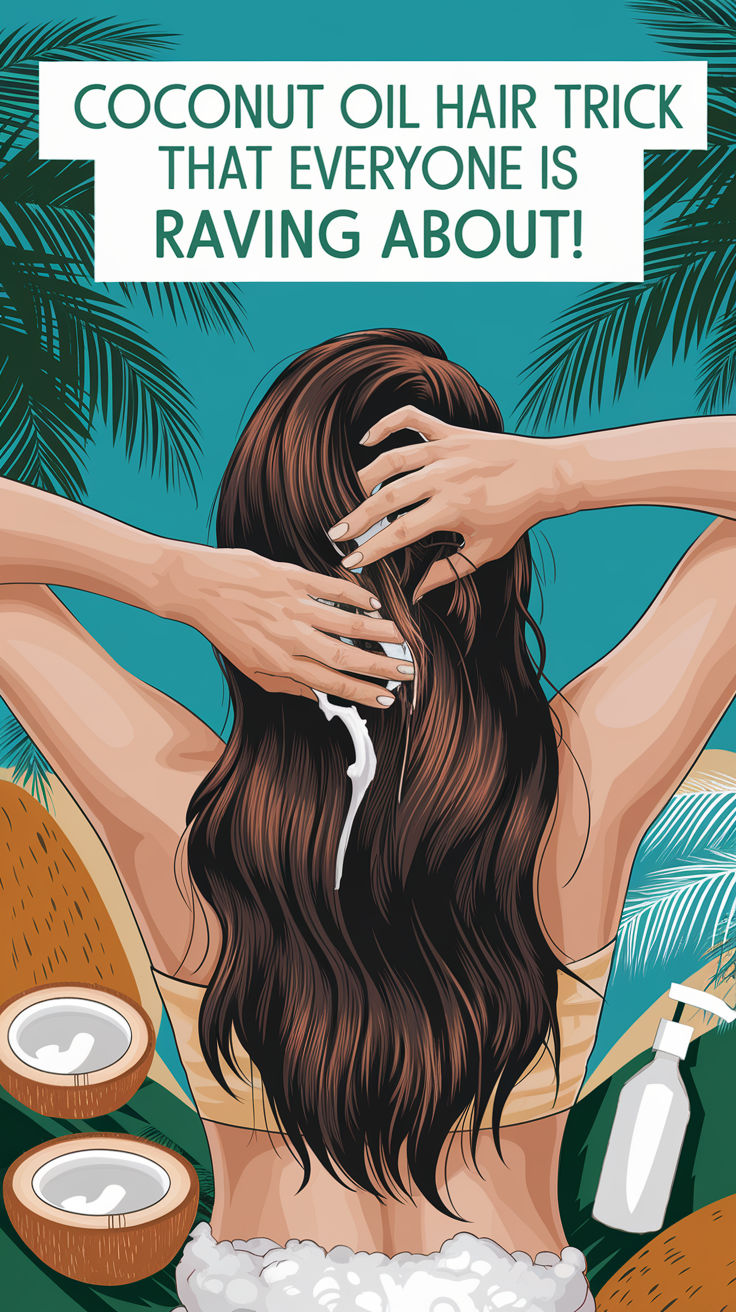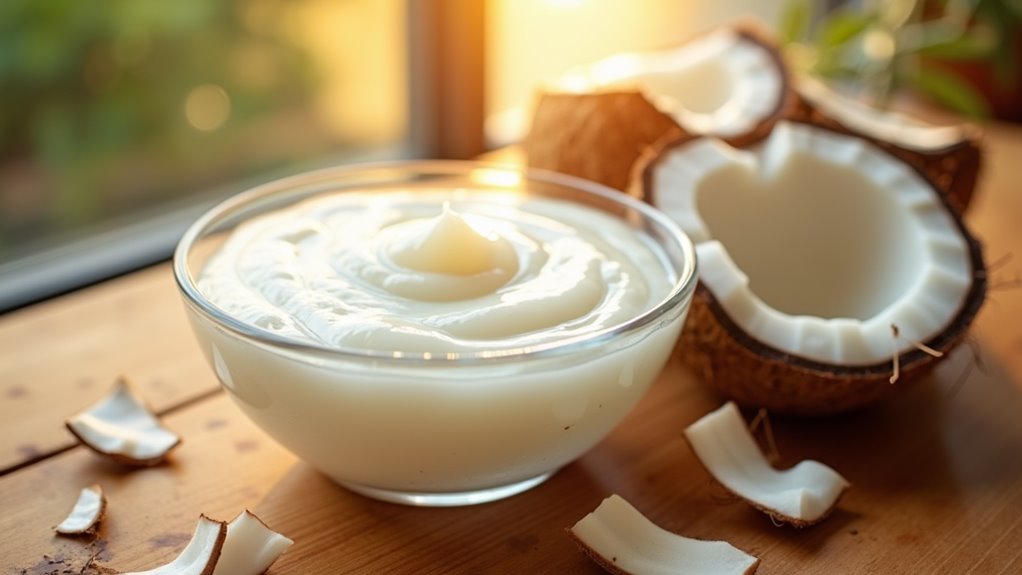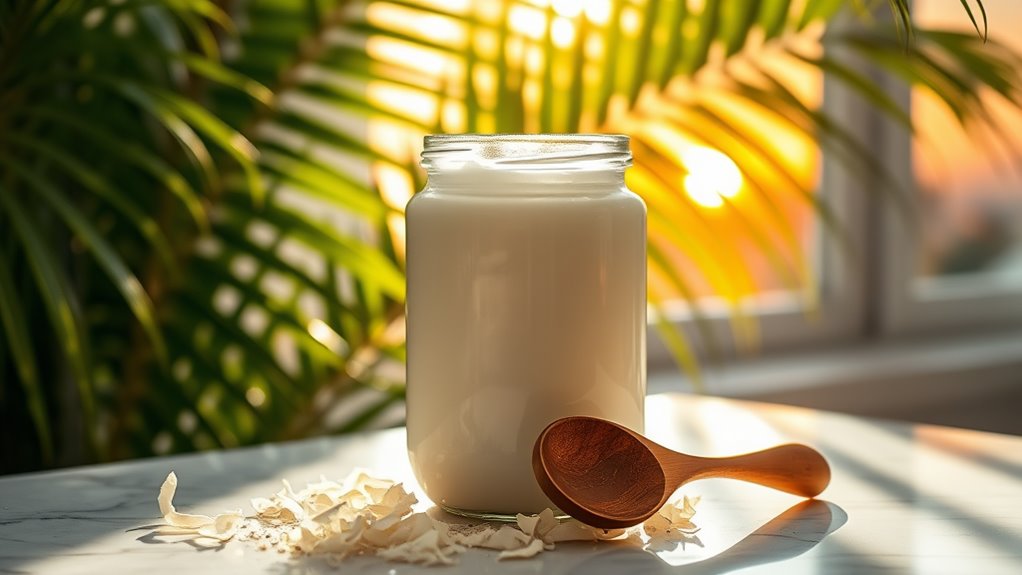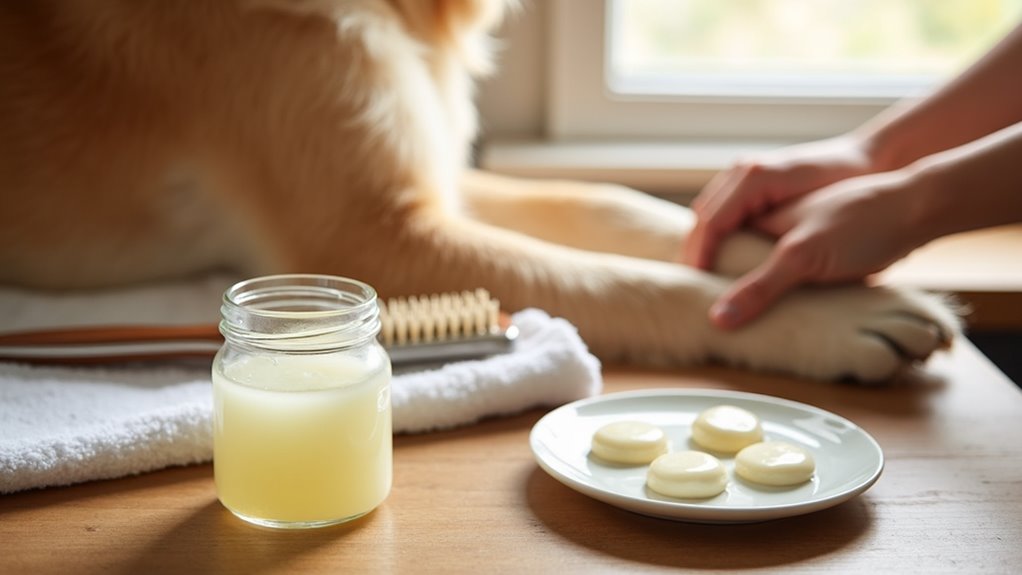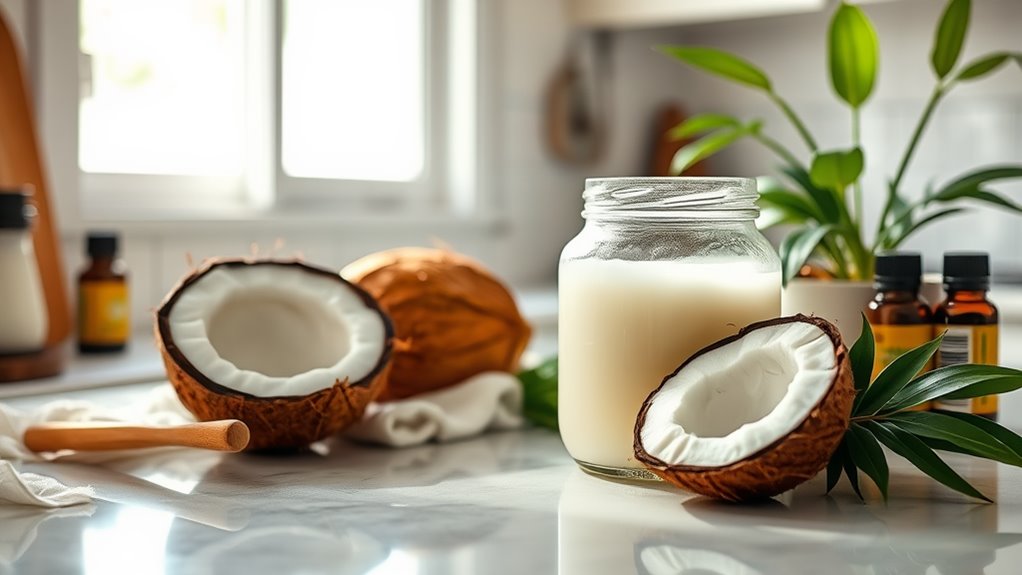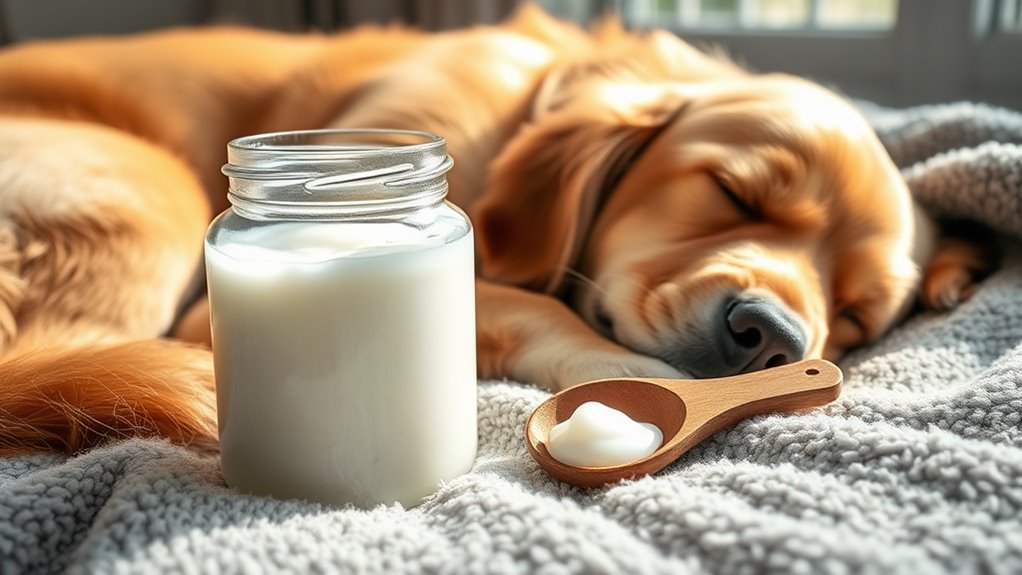Coconut Oil Hair Trick That Everyone Is Raving About!
The viral coconut oil hair trick everyone’s talking about isn’t just hype – it’s backed by science! You’ll want to warm virgin coconut oil between your palms, section your hair, and apply it from roots to tips. Leave it on for 30 minutes or overnight for deeper conditioning. Thanks to its unique molecular structure, coconut oil penetrates deep into your hair shaft instead of just coating it. There’s more to this transformative treatment than meets the eye.
Key Takeaways
-
Apply slightly damp coconut oil overnight, wrapping hair in a warm towel for maximum absorption and transformative results.
-
Warm virgin coconut oil between palms before application to ensure deep penetration into the hair shaft.
-
Section hair into four parts and work oil from roots to tips, focusing on damaged areas.
-
Use coconut oil as a pre-shampoo treatment to prevent protein loss and protect hair during washing.
-
Mix coconut oil with your regular conditioner for an enhanced moisturizing effect without heaviness.
Why Coconut Oil Is Your Hair’s Best Friend
Unlike most hair products that simply coat your strands, coconut oil penetrates deep into the hair shaft to nourish and protect from within.
You’ll join thousands of satisfied users who’ve discovered this natural wonder’s ability to reduce protein loss and prevent damage from styling and environmental stress.
The secret lies in coconut oil’s unique molecular structure, which lets it absorb into your hair rather than sitting on top.
When you apply a coconut oil hair mask, you’re treating your locks to a rich blend of fatty acids that combat frizz, split ends, and breakage.
It’s the same treatment that beauty experts and celebrities swear by for maintaining their enviable locks.
Best of all, you’re using a pure, natural ingredient that’s been trusted for generations to deliver stronger, shinier, and healthier hair.
The Science Behind Coconut Oil’s Hair Benefits
Scientists have uncovered exactly why coconut oil works so effectively for hair care. Unlike other oils, coconut oil’s unique molecular structure allows it to penetrate deep into your hair shaft. Its low molecular weight and straight linear chain structure mean it can slip right into your hair’s cortex, where it matters most.
You’ll find that coconut oil’s lauric acid content is what makes it special. This medium-chain fatty acid has a particular affinity for hair proteins, helping prevent protein loss during washing and styling.
When you apply coconut oil, it forms a protective layer that reduces hygral fatigue – the stress your hair experiences from repeated swelling and drying.
Plus, its antimicrobial properties keep your scalp healthy by fighting off harmful bacteria and fungi that can cause dandruff and irritation.
Essential Tools and Materials You’ll Need
Before starting your coconut oil hair treatment, you’ll need to gather a few basic items to guarantee the best results. The essentials include high-quality virgin coconut oil, a small microwave-safe bowl for heating, and a wide-toothed comb to distribute the oil evenly through your hair.
You’ll also want to have these handy items ready: a shower cap or plastic wrap to cover your hair, old towels to protect your clothes and surfaces, hair clips to section your strands, and a gentle sulfate-free shampoo for washing out the oil later.
If you’re planning to apply the treatment to your scalp, grab a scalp massage tool or use your fingertips. Don’t forget to set up a timer on your phone to track the treatment duration.
Selecting the Right Type of Coconut Oil
Choosing the right coconut oil can make or break your hair treatment results. You’ll want to look for unrefined, virgin coconut oil that’s organic and cold-pressed to guarantee you’re getting the maximum benefits for your hair.
| Type | Best For |
|---|---|
| Virgin | Deep conditioning |
| Extra virgin | Scalp treatments |
| Refined | Daily styling |
| Fractionated | Leave-in treatments |
| MCT | Quick absorption |
Before purchasing your coconut oil, check the label carefully. The purest forms will have just one ingredient: coconut oil. If you spot any additional ingredients or processing methods, it’s likely not the best choice for your hair care routine. Many beauty enthusiasts swear by brands that come in glass containers, as they tend to maintain better quality over time.
Pre-Treatment Hair Preparation Steps
To get the most out of your coconut oil treatment, you’ll need to properly prepare your hair first. Start by gently detangling your dry hair with a wide-toothed comb, working from the ends up to prevent breakage.
Next, thoroughly cleanse your hair with a sulfate-free shampoo to remove any product buildup.
If you’re dealing with particularly stubborn buildup, try using an apple cider vinegar rinse before applying the oil. Just mix one part vinegar with three parts water.
Once your hair is clean, pat it with a microfiber towel until it’s damp but not soaking wet. This ideal moisture level will help your strands absorb the coconut oil more effectively, giving you those silky-smooth results everyone’s talking about.
How to Melt Coconut Oil Properly
Since coconut oil solidifies at room temperature, you’ll need to transform it into a liquid state for easy application. Here’s how to melt it safely while preserving its beneficial properties for your hair.
| Method | Instructions |
|---|---|
| Double Boiler | Place oil in glass bowl over pot of simmering water; stir until melted |
| Microwave | Heat in 10-second intervals, stirring between each burst |
| Hands | Scoop small amount and rub between palms until melted |
Choose the method that works best for you, but remember not to overheat the oil. The ideal temperature should feel warm, not hot, when tested on your wrist. If it’s too hot, let it cool for a few minutes before applying it to your hair to avoid scalp irritation or damage to your strands.
Mixing Coconut Oil With Other Natural Ingredients
While coconut oil works wonders on its own, combining it with other natural ingredients can enhance its hair-nourishing properties.
You’ll love mixing it with honey for added moisture and shine, or with aloe vera gel to soothe your scalp. For an amazing deep conditioning treatment, blend coconut oil with mashed avocado – it’s packed with healthy fats that your hair will drink up.
Join the growing community of natural hair care enthusiasts by creating your own signature blend.
Try mixing coconut oil with essential oils like lavender for relaxation, tea tree for scalp health, or rosemary for hair growth. You can also add a few drops of argan oil or jojoba oil to create a super-moisturizing elixir that’ll transform your locks.
Step-by-Step Application Guide
Following these simple steps will guarantee you get the most out of your coconut oil hair treatment.
Start by warming 2-3 tablespoons of coconut oil between your palms until it’s completely melted.
Section your dry hair into four parts, then apply the oil from roots to tips, massaging gently as you go. Pay extra attention to your ends, where damage is most common.
Wrap your hair in a warm towel or shower cap and let the oil work its magic for at least 30 minutes – though many in our beauty community swear by overnight treatment.
When you’re ready, shampoo thoroughly using lukewarm water. You might need two washes to remove all the oil.
Follow with your regular conditioner, and you’ll join thousands of others enjoying silky, nourished locks.
Best Timing for Maximum Results
The perfect timing of your coconut oil hair treatment can make all the difference in its effectiveness. For the best results, apply your treatment at night before bed and leave it in for 8-12 hours. This overnight method allows the oil to deeply penetrate your strands while you sleep.
If you’re short on time, you’ll still get benefits from a 2-hour treatment before washing your hair. Just be sure to plan your treatment when you won’t need to go out, as the oil will make your hair appear wet and greasy.
For those with fine hair, stick to shorter treatment times of 30 minutes to avoid weighing down your strands. Remember to always apply the oil to dry hair, as wet hair won’t absorb the coconut oil as effectively.
Protecting Your Pillowcase and Bedding
Protecting your bedding during an overnight coconut oil treatment requires a few simple precautions. Cover your pillow with an old pillowcase you don’t mind getting oily, or wrap your hair in a silk scarf or shower cap before going to bed.
You’ll want to lay an old towel over your pillow for extra protection, since oil can seep through fabrics.
For a foolproof solution that many coconut oil enthusiasts swear by, try using a microfiber towel as your pillowcase – it’s super absorbent and washable.
If you’re worried about stains, place a dark-colored towel underneath your head.
Remember to change your regular pillowcase the next morning, even if you’ve used protection, to prevent any lingering oil from transferring to your clean hair.
Proper Washing Techniques After Treatment
Washing out coconut oil from your hair requires extra attention to guarantee you remove all residue effectively. Start with a generous amount of shampoo, focusing on your scalp with gentle circular motions. You’ll likely need two rounds of shampooing to cut through the oil completely.
Don’t skip these essential steps that fellow coconut oil enthusiasts swear by: First, apply the shampoo to your dry hair before wetting it – this helps break down the oil more efficiently.
Then, use warm (not hot) water to create a rich lather. After thoroughly rinsing, follow up with your regular conditioner, but apply it only from mid-shaft to ends.
A final cool water rinse will help seal your hair cuticles and lock in the treatment’s benefits.
How Often to Use Coconut Oil Treatment
Finding your ideal coconut oil treatment schedule depends on your hair type and its specific needs. If you’ve got dry, damaged, or coarse hair, you’ll benefit from using coconut oil twice a week.
For normal to oily hair types, stick to once-weekly treatments to avoid weighing down your strands.
Like many in our natural hair care community, you might notice better results by starting with more frequent applications and then adjusting based on how your hair responds. If you’re new to coconut oil treatments, begin with once a week and watch how your hair reacts.
You’ll know you’ve found the right frequency when your hair feels soft and manageable without looking greasy or feeling heavy. During winter months, you may need slightly more frequent treatments to combat seasonal dryness.
Common Mistakes to Avoid
While establishing your ideal coconut oil schedule matters, knowing what not to do can make or break your results. Many of us have made these common mistakes, but you’ll be ahead of the curve by avoiding them.
| Mistake | What to Do Instead |
|---|---|
| Using too much oil | Start with a quarter-sized amount |
| Applying to dry hair | Dampen hair slightly first |
| Not heating the oil | Warm between palms or microwave briefly |
| Skipping the roots | Massage thoroughly from scalp to ends |
Watch out for these slip-ups that could prevent you from getting those enviable results you’re after. Remember, you’re not alone in this journey – everyone starts somewhere, and learning from others’ experiences will help you achieve those silky, healthy locks you’ve been dreaming of.
Tips for Different Hair Types
Just as everyone’s wardrobe differs, your hair needs a customized coconut oil treatment based on its unique texture and density.
If you’ve got fine hair, apply a light coating from mid-shaft to ends and leave it on for 30 minutes.
For medium-textured hair, you’ll want to use a moderate amount and let it sit for 2-3 hours.
Those with thick or coarse hair can benefit from generous application and overnight treatment.
For curly hair, focus on working the oil through each curl pattern while your hair’s damp.
Straight-haired folks should apply from roots to tips in downward strokes.
If you’re dealing with an oily scalp, start your application an inch away from the roots.
Expected Results and Timeline
Your coconut oil journey will show noticeable improvements within the first few applications.
You’ll notice softer, more manageable hair after just one treatment, while deeper benefits develop over time. Most people see reduced frizz and increased shine within 2-3 weeks of regular use.
For best results, maintain a consistent routine of 1-2 applications per week for at least two months.
You’ll join countless others who’ve experienced stronger strands, less breakage, and healthier scalp conditions by the 8-week mark. If you’re dealing with severe damage or dryness, you might need 3-4 months to achieve your desired transformation.
Remember that everyone’s hair responds differently, but you’re sure to see positive changes if you stay committed to the process.
Storing Your Coconut Oil Properly
To maintain coconut oil’s beneficial properties, proper storage is essential.
Keep your coconut oil in a cool, dark place away from direct sunlight and heat sources. Your pantry or bathroom cabinet is ideal, as long as it’s not near your shower where steam can affect the oil’s quality.
You’ll want to store your oil in an airtight glass container rather than plastic, as glass won’t leach harmful chemicals.
If you’re living in a warm climate where the oil stays liquid, that’s perfectly fine – coconut oil is stable in both solid and liquid states.
Just make sure to seal the container tightly after each use and check for any signs of rancidity, like an off smell or yellowish color.
Your oil should stay fresh for up to two years when stored correctly.
Combining With Other Hair Care Routines
While storing coconut oil correctly preserves its effectiveness, integrating it into your existing hair care routine can maximize its benefits.
You’ll get the best results by applying coconut oil before your regular shampoo as a pre-treatment, or after washing as a leave-in conditioner. If you’re a fan of deep conditioning masks, mix coconut oil with honey and avocado for an ultra-nourishing treatment.
For those who love their styling products, you can blend a small amount of melted coconut oil with your favorite serums or creams. Just remember to use less of your regular product since the oil adds extra moisture.
On wash days, try adding a few drops of coconut oil to your shampoo for extra protection, or use it as a natural detangler before combing.
Troubleshooting Common Issues
Despite coconut oil’s numerous benefits, some users encounter challenges that can affect their results.
If you’re experiencing greasiness, you’re likely using too much product – start with a small amount and adjust as needed. For those with fine hair who find coconut oil too heavy, try applying it only to your ends or diluting it with lighter oils like argan or jojoba.
Noticed your hair feeling stiff or waxy? You might need to adjust your washing technique. Use warm water to help the oil emulsify, and consider double-shampooing if necessary.
If you’re seeing flakes, verify you’re not applying the oil to a dry, flaky scalp – treat any underlying scalp conditions first.
Frequently Asked Questions
Can I Use Coconut Oil Treatment Right Before Coloring My Hair?
You shouldn’t apply coconut oil before coloring your hair. It’ll create a barrier that prevents the dye from penetrating your strands properly, leading to uneven or ineffective color results.
Will Coconut Oil Make My Scalp More Prone to Sunburn?
You won’t need to worry about increased sunburn risk. In fact, coconut oil offers some natural UV protection for your scalp, though you should still use proper sun protection outdoors.
Does Coconut Oil Affect the Hold of Hair Styling Products?
You’ll notice coconut oil weakens your styling products’ hold since it creates a slick barrier. It’s best to skip it on days when you’re planning to style your hair.
Can Coconut Oil Treatments Help With Headlice Prevention?
You’ll love that coconut oil can help prevent lice infestations. Its fatty acids create a slippery barrier that makes it harder for lice to grab onto your hair strands.
Does Coconut Oil Lose Its Benefits if I Heat It in the Microwave?
You won’t lose the benefits by gently heating coconut oil in the microwave. Just don’t overheat it – warm it in short bursts until it’s just melted for best results.


